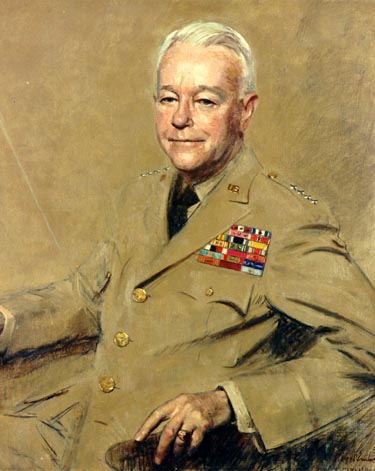
Joseph Lawton Collins was born in New Orleans, Louisiana, on 1 May 1896; graduated from the United States Military Academy, 1917; was commissioned a second lieutenant and assigned to the 22d Infantry, April 1917; was promoted to first lieutenant, May 1917, and temporary captain, August 1917; attended the Infantry School of Arms at Fort Sill and served with his regiment at various locations, 1917–1919; was promoted to captain, June 1918, and to temporary major, September 1918; commanded the 3d Battalion, 22d Infantry, in France, 1919, and was assistant chief of staff, G–3, of American Forces in Germany, 1920–1921; married Gladys Easterbrook, 1921; reverted to captain, 1920; was instructor in the department of chemistry at West Point, 1921–1925; graduated from the company officer course at the Infantry School, Fort Benning, 1926, and from the advanced course at the Field Artillery School, Fort Sill, 1927; was an instructor in weapons and tactics at the Infantry School, 1927–1931; was promoted to major, August 1932; was executive officer of the 23d Brigade, Manila, and assistant chief of staff, G–2, Philippine Division, 1933–1934; graduated from the Army Industrial College, 1937, and the Army War College, 1938; was an instructor at the Army War College, 1938–1940; was promoted to lieutenant colonel, June 1940; was chief of staff of the VII Corps, 1941; was promoted to the temporary ranks of colonel, January 1941, brigadier general, February 1942, and major general, May 1942; was chief of staff of the Hawaiian Department, 1941–1942, and commanding general of the 25th Infantry Division on Oahu and in operations against the Japanese on Guadalcanal, 1942–1943; commanded VII Corps in the Normandy invasion and in Western European campaigns to the German surrender, 1944–1945; was promoted to temporary lieutenant general (April) and permanent brigadier general (June), 1945; was deputy commanding general and chief of staff of Army Ground Forces, August–December 1945; was director of information (later chief of public information) of the Army, 1945–1947; was deputy (later vice) chief of staff of the United States Army, 1947–1949; was promoted to temporary general and permanent major general, January 1948; was chief of staff of the United States Army, 16 August 1949–15 August 1953; was the Army’s senior officer throughout the Korean War, directed the Army’s operation of the railroads, brought the first Special Forces group into the order of battle, and was closely associated with the development of the Army’s contribution to the newly established North Atlantic Treaty Organization; was representative of the United States to the Military Committee and the Standing Group of NATO, 1953–1954; was special representative of the United States in Vietnam with ambassadorial rank, 1954–1955; returned to his NATO assignment; retired from active service, March 1956; died in Washington, D.C., on 12 September 1987.
The Artist
Lloyd Bowers Embrey (1913–1979) was born in Washington, D.C. He studied there at the Corcoran School of Art in his younger years, was granted a scholarship at the Phillips Gallery, and then completed his specialized education with a degree in fine arts from Yale University. He maintained a studio adjoining his home in the nation’s capital, and his geographical location provided every potential for his chosen field of portraiture. His subjects included prominent figures in various walks of life: government, business, society, the professions. He particularly enjoyed painting beautiful women and specialized in studies of children. Mr. Embrey painted oil portraits of two of the Army’s chiefs of staff: General J. Lawton Collins and Earle G. Wheeler.
Joseph Lawton Collins
By Lloyd Bowers Embrey
Oil on canvas, 40" x 40", 1972
[126]

[127]